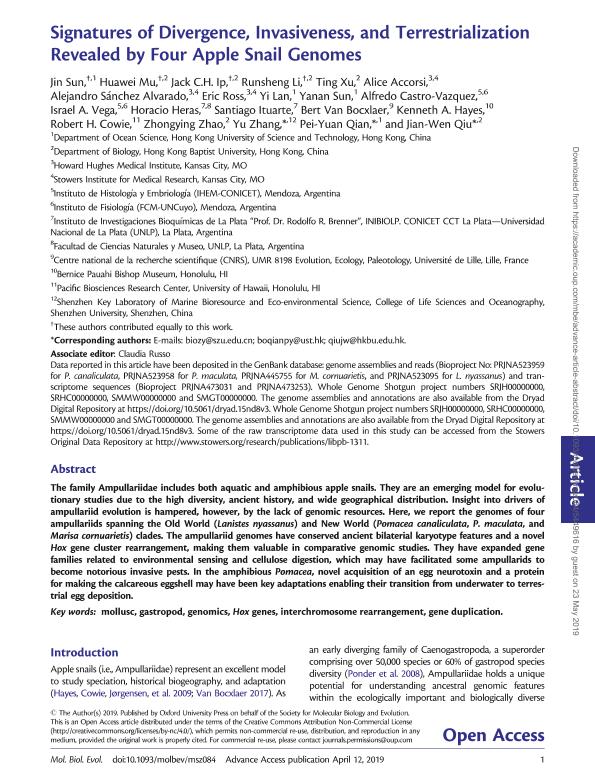Artículo
Signatures of divergence, invasiveness, and terrestrialization revealed by four apple snail genomes
Sun, Jin; Mu, Huawei; Ip, Jack Chi Ho; Li, Runsheng; Xu, Ting; Accorsi, Alice; Alvarado, Alejandro Sanchez; Ross, Eric; Lan, Yi; Sun, Yanan; Castro Vazquez, Alfredo Juan ; Vega, Israel Aníbal
; Vega, Israel Aníbal ; Heras, Horacio
; Heras, Horacio ; Ituarte, Santiago
; Ituarte, Santiago ; Van Bocxlaer, Bert; Hayes, Kenneth A.; Cowie, Robert H.; Zhao, Zhongying; Zhang, Yu; Qian, Pei-Yuan; Qiu, Jian-Wen
; Van Bocxlaer, Bert; Hayes, Kenneth A.; Cowie, Robert H.; Zhao, Zhongying; Zhang, Yu; Qian, Pei-Yuan; Qiu, Jian-Wen
 ; Vega, Israel Aníbal
; Vega, Israel Aníbal ; Heras, Horacio
; Heras, Horacio ; Ituarte, Santiago
; Ituarte, Santiago ; Van Bocxlaer, Bert; Hayes, Kenneth A.; Cowie, Robert H.; Zhao, Zhongying; Zhang, Yu; Qian, Pei-Yuan; Qiu, Jian-Wen
; Van Bocxlaer, Bert; Hayes, Kenneth A.; Cowie, Robert H.; Zhao, Zhongying; Zhang, Yu; Qian, Pei-Yuan; Qiu, Jian-Wen
Fecha de publicación:
07/2019
Editorial:
Oxford University Press
Revista:
Molecular Biology and Evolution
ISSN:
0737-4038
e-ISSN:
1537-1719
Idioma:
Inglés
Tipo de recurso:
Artículo publicado
Clasificación temática:
Resumen
The family Ampullariidae includes both aquatic and amphibious apple snails. They are an emerging model for evolutionary studies due to the high diversity, ancient history, and wide geographical distribution. Insight into drivers of ampullariid evolution is hampered, however, by the lack of genomic resources. Here, we report the genomes of four ampullariids spanning the Old World (Lanistes nyassanus) and New World (Pomacea canaliculata, P. maculata, and Marisa cornuarietis) clades. The ampullariid genomes have conserved ancient bilaterial karyotype features and a novel Hox gene cluster rearrangement, making them valuable in comparative genomic studies. They have expanded gene families related to environmental sensing and cellulose digestion, which may have facilitated some ampullarids to become notorious invasive pests. In the amphibious Pomacea, novel acquisition of an egg neurotoxin and a protein for making the calcareous eggshell may have been key adaptations enabling their transition from underwater to terrestrial egg deposition.
Archivos asociados
Licencia
Identificadores
Colecciones
Articulos(IHEM)
Articulos de INST. HISTOLOGIA Y EMBRIOLOGIA DE MEND DR.M.BURGOS
Articulos de INST. HISTOLOGIA Y EMBRIOLOGIA DE MEND DR.M.BURGOS
Articulos(INIBIOLP)
Articulos de INST.DE INVEST.BIOQUIMICAS DE LA PLATA
Articulos de INST.DE INVEST.BIOQUIMICAS DE LA PLATA
Citación
Sun, Jin; Mu, Huawei; Ip, Jack Chi Ho; Li, Runsheng; Xu, Ting; et al.; Signatures of divergence, invasiveness, and terrestrialization revealed by four apple snail genomes; Oxford University Press; Molecular Biology and Evolution; 36; 7; 7-2019; 1507-1520
Compartir
Altmétricas



